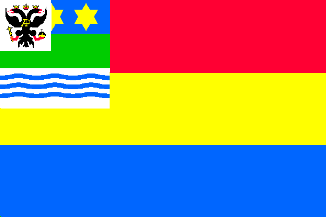
This page is part of © FOTW Flags Of The World website
Anna Paulowna (The Netherlands)
Noord-Holland province
Last modified: 2004-10-23 by jarig bakker
Keywords: anna paulowna |
Links: FOTW homepage |
search |
disclaimer and copyright |
write us |
mirrors
 Shipmate Flagchart : http://www.shipmate.nl/flags.htm
Shipmate Flagchart : http://www.shipmate.nl/flags.htm
never officially adopted
See also:
Anna Paulowna municipality
14.000 inhabitants, 8000 hectares, with the villages of Anna Paulowna,
Breezand, Wieringerwaard, Nieuwesluis and Van Ewijcksluis. This municipality
is in northern Noordholland, between Den Helder and Wieringen and consists
of a polder created in 1845-46, named after the daughter of Czar Paul I
of Russia, Anna Paulowna (1795-1865), married to
King Willem II of the Netherlands. It became an independent municipality
in 1870. The first settlers came from Gelderland; in 1912 it appeared that
the soil was good for growing bulbs, after which people from the Westland
(Zuidholland) settled here. Bee-keepers and potatoes-growers joined the
fun. In 1990 part of the former municipality of Barsingerhorn was added
to Anna Paulowna. Wieringerwaard was an independent municipality till 1970,
when in merged with Barsingerhorn.
Flagdescription: three equally high stripes of red, yellow and blue
with a canton charged with the municipal arms.
Never officially adopted; design: unknown.
Jarig Bakker, 21 June 2001
Anna Paulowna CoA
![[Anna Paulowna CoA]](../images/n/nl-nh)ap.jpg) image from the Anna Paulowna municipal
website.
image from the Anna Paulowna municipal
website.
Granted 24 May 1872
The eagle reminds of Grandduchess Anna Paulowna, daughter of Czar Paul
I of Russia; she married King Willem II, and this municipality was named
after her. The green central part suggests land gained from the sea by
"inpodering"; the water is symbolized by the wavy base, while the chief
represents the starry sky.
Barsingerhorn [former municipality]
Barsingerhorn is a former municipality in Noordholland, divided in 1990
between Anna Paulowna and Niedorp. In 1981 there were 3800 inhabitants
on 3912 hectares. Administrative center: Barsingerhorn; other villages:
Haringhuizen, Kolhorn, Wieringerwaard. In 1830 Kolhorn and Haringhuizen
were added to this municipality. In 1970 the municipalities Wieringerwaard
and Barsingerhorn were joined to a single municipality Barsingerhorn. Barsingerhorn
got city rights from Count Willem VI of Holland (=Duke Wilhelm II of Bavaria)
in 1415. Locally they speak of "Barregorn" and about Kolhorn as "Klorn".
Kolhorn used to be a fishing port on the Zuiderzee, hence the nickname
"Rotte" (rats) because of the rats in the fish-warehouses...
Sierksma's Nederlands vlaggenboek (1962) has the colors red, yellow,
blue and white for Barsingerhorn.
Jarig Bakker, 8 July 2001
Barsingerhorn CoA
See International Civic Arms : http://www.ngw.nl/
 Shipmate Flagchart : http://www.shipmate.nl/flags.htm
Shipmate Flagchart : http://www.shipmate.nl/flags.htm

 Shipmate Flagchart : http://www.shipmate.nl/flags.htm
Shipmate Flagchart : http://www.shipmate.nl/flags.htm
![[Anna Paulowna CoA]](../images/n/nl-nh)ap.jpg) image from the Anna Paulowna municipal
website.
image from the Anna Paulowna municipal
website.